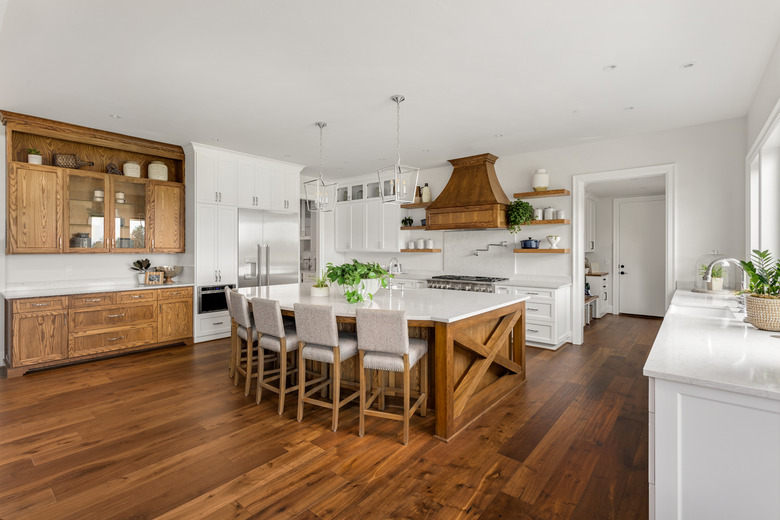How To Gel Stain Laminate Cabinets With A Faux Wood Finish
Real wood cabinets give your kitchen an elegant, rustic appeal. Unfortunately, real wood cabinets are often expensive. Plastic laminate cabinets have the appearance of real wood and are a more budget-friendly option. It is also possible to use gel stain on laminate cabinets for a real-wood look.
Choosing to Stain Fake Wood
Choosing to Stain Fake Wood
If you ever decide to change the color of your cabinets and want to use traditional stains or methods, you may run into trouble. A standard wood stain works well for wooden cabinets, but you don't get the same results when applying liquid stain to fake wood.
Fortunately for those with laminate cabinets, gel stain works well on a variety of surfaces other than real wood — allowing you to stain your cabinets without leaving them a streaky, splotchy mess. You could choose to use Minwax Polyshades to stain laminate, or a similar brand.
Preparing to Stain Cabinets
Preparing to Stain Cabinets
First, be sure that your work area is well ventilated. If you will be staining the cabinets in place, open any doors or windows that you can, and use a fan when possible. If you are moving the cabinets, or are working with cabinets that have just been purchased and are not yet installed, be sure your workspace is well ventilated, too. This means opening windows or doors in basements and garages.
Next, it is essential that you prep the surfaces of the cabinets before getting started. Clean the cabinets well with a mild household cleanser and a soft cloth.
Sanding the Cabinets
Sanding the Cabinets
Sand the surface of your cabinets with 100-grit sandpaper. Laminate cabinets often have a slick finish. Sanding roughens the surface of your cabinets, helping the gel stain stick more easily.
Dampen a washcloth with mineral spirits. Wipe down the sanded surface well, removing all of the sanding dust left behind. Let the cabinets dry thoroughly before proceeding with additional work.
Applying the Gel Stain
Applying the Gel Stain
Open the can of gel stain. Dip a clean, lint-free cloth into the gel stain. Wipe a thick layer of gel stain across the cabinet.
Wipe away the excess gel stain with a second lint-free cloth. Continue applying the gel stain and wiping away the excess until you finish staining the cabinets. Let the gel stain dry.
Apply a second coat of gel stain if you do not achieve the desired results with the first application.
Finishing Your Cabinets
Finishing Your Cabinets
Because your cabinets are not real wood, you do not have to worry about going against the grain while sanding or staining like you would if you were staining genuine wood.
Gel stain dries quickly. Work in small sections to prevent excess gel stain from drying on your cabinet's surface before you can wipe it away. You can combine colors by staining your cabinets in one shade and applying a different shade of stain after the first coat dries.
Any stains, food smears or marks on your cabinets that you do not clean away before applying the gel stain will remain on the cabinet's surface indefinitely. You cannot clean away marks after staining your cabinets. Thus, it is imperative that you clean the cabinets thoroughly before you begin this project.
